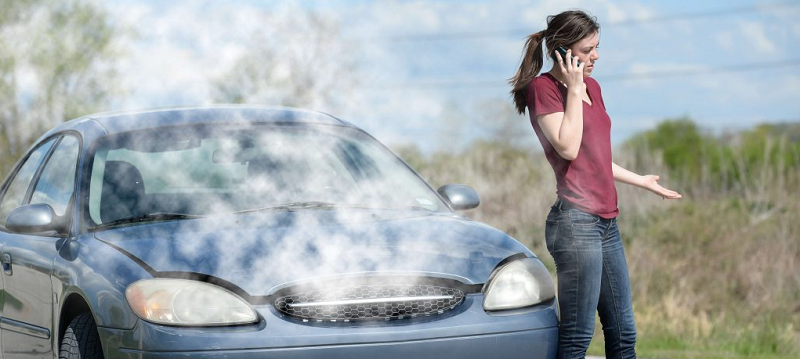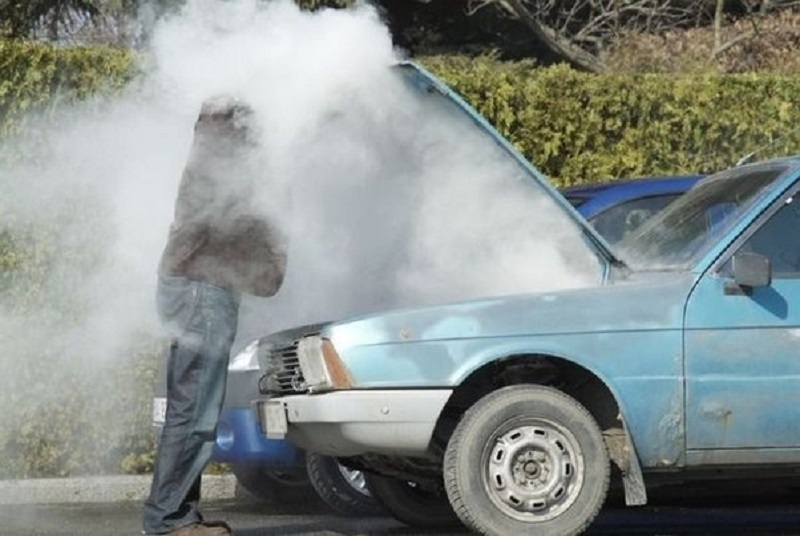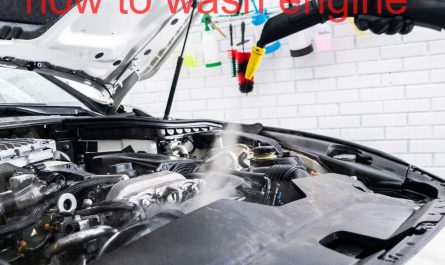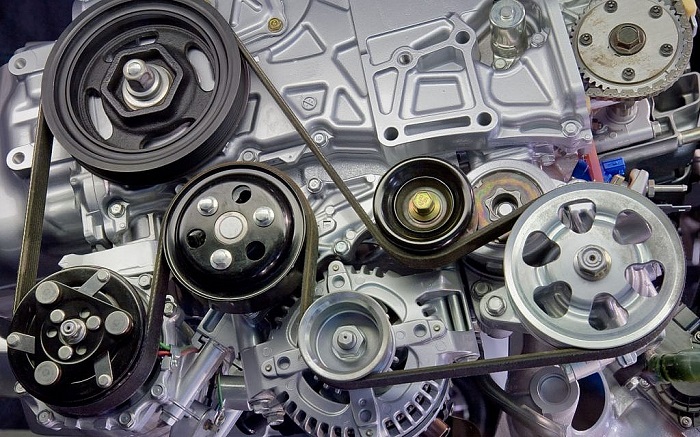
There are several possible causes for an Overheating Automobile. These are a few typical causes:
Coolant Issues: A coolant leak or low coolant levels can make it difficult for your engine to cool down correctly. Inspect for leaks in the coolant reservoir, hoses, or radiator.
Thermostat Problems: The engine’s coolant flow is regulated by the thermostat. It can stop coolant from circulating if it’s locked shut, which could cause overheating.
Radiator Issues: Coolant flow may be impeded by a blocked radiator or a faulty radiator. The radiator’s efficiency may be impacted by corrosion, dirt, or debris.
Water Pump Failure: Coolant is pumped through the radiator and engine via the water pump. In the event that it malfunctions, improper coolant circulation will lead to engine overheating.
Broken Fan: The radiator fan on your car aids in coolant cooling. The engine may overheat if the fan isn’t operating because of a blown fuse or a malfunctioning motor.
Hoses and Belts: Coolant leaks or inadequate coolant circulation can be caused by hoses and belts that are damaged or fractured.
Head Gasket Issues: Coolant leakage into the engine due to a burst head gasket can lead to overheating and other severe engine issues.
Clogged Coolant System: Rust and debris can accumulate over time in the coolant system, obstructing the coolant’s flow and leading to overheating.
Read more:2024 Toyota GR Supra Brand Car
What should I do if my car’s overheating?
It’s critical to act quickly to stop additional damage if your automobile is overheating. This is what you ought to do:
Pull Over Safely: Find a safe spot to pull over as soon as you see the warning light appear or the temperature gauge begin to rise. Driving while your automobile is hot might seriously harm the engine.
Turn Off the Engine: To stop the engine from overheating any further, stop it once you’re parked. Give it time to calm down before attempting any further actions.
Wait for the Engine to Cool: Before you open the hood or try to check anything, let the engine cool down. It may require a minimum of 15 to 30 minutes. Because of the vapor and hot coolant, opening the hood while the engine is still hot might be hazardous.
Check Coolant Levels: Check for low coolant levels in the radiator and coolant reservoir (if accessible) after the engine has cooled. It could be necessary to add more coolant if it’s low. Nevertheless, as hot coolant might burn, only remove the radiator cap once the engine has totally cooled.
Inspect for Leaks: Look for any pools or stains that can indicate coolant leakage beneath the vehicle and around the engine compartment. Leaks may be a sign of an issue with the water pump, radiator, or hoses.
Check the Thermostat and Radiator Fan: Verify that the fan on the radiator is operating correctly. If the fan isn’t operating, there may be a problem with the fan motor or an electrical problem.
Add Coolant if Necessary: Use the kind of coolant recommended in your car’s owner’s manual if you need to add any. Most auto parts retailers commonly carry a mixture of water and antifreeze. See your handbook or a specialist if you’re unclear about what to use.
Drive to a Mechanic: Drive the vehicle to a local mechanic if you can, so they can perform a comprehensive inspection. If the overheating continues or you’re unsure of the cause, it’s preferable to get the problem diagnosed and fixed by an expert.
Avoid Overheating Again: Maintain routine maintenance, which includes monitoring and replenishing coolant levels and making sure the cooling system is functioning properly, to avoid overheating in the future.
Read more: Brake Caliper Cost And Replacement
What does the temperature warning light mean?
An important warning that the engine of your car is operating at a higher temperature than usual is the temperature warning light on the dashboard. When this light comes on while you’re driving, it usually means that the engine is overheating. This can be caused by a number of problems, including low coolant levels, broken thermostats, or broken radiator fans. Even while there might not be an imminent threat when the light is steady, it’s still vital to pull over securely and take care of the problem because the engine is likely hotter than usual.
A more serious issue, indicating rapid overheating, is indicated if the indicator is flashing. In these situations, check the coolant levels and look for leaks after stopping the engine as soon as it is safe to do so and letting it cool. To identify and resolve the underlying problem, you must get professional assistance from a mechanic if the light stays on or if you have other symptoms. Frequent upkeep and observation can assist avert any engine damage and stop the temperature warning light from coming on.
How long will it take my car to cool down after overheating?
The amount of overheating, the outside temperature, and the particular make and model of your automobile can all affect how long it takes for your car to cool down after overheating. Generally speaking, you should wait at least 15 to 30 minutes before opening the hood or doing any other action to allow the engine to cool down sufficiently.
How can I prevent my engine overheating?
Regular maintenance and watching out for any problems are key to keeping your engine from overheating. To keep your engine cool, follow these important steps:
Regularly Check Coolant Levels: Make sure the antifreeze (coolant) in your vehicle is the right amount. When the engine is cold, check the radiator and coolant reservoir and top it off with the type recommended in your owner’s manual.
Inspect and Maintain the Cooling System: Make routine checks for leaks, corrosion, and blockages in your cooling system. Make that the water pump, hoses, and radiator are all in good operating order.
Flush the Radiator: Debris and deposits may accumulate in the radiator over time, reducing its effectiveness. Maintaining appropriate coolant flow can be facilitated by routinely flushing the radiator, as advised by the manufacturer of your car.
Check the Thermostat: The engine’s coolant flow is controlled by the thermostat. Verify that it’s operating correctly because a malfunctioning thermostat might impede the right flow of coolant and cause overheating.
Ensure the Radiator Fan is Working: Coolant is aided in cooling by the radiator fan. Verify that the fan is functioning properly, particularly while the engine is idle or there is sluggish traffic. If you think something may be wrong, check the fan’s wiring and fuse.
Inspect Belts and Hoses: Make sure you periodically inspect belts and hoses for wear, cracks, or leaks. As soon as possible, replace any damaged belts or hoses to prevent coolant loss and overheating.
Monitor for Leaks: Keep an eye out for any indications of coolant leakage, such puddles beneath the vehicle or a pleasant scent. Take quick action to fix any leaks to stop coolant loss.
Keep the Radiator and Air Vents Clean: Make sure there are no leaves, dirt, or debris in the air vents or radiator. Blockages may limit airflow and lower the effectiveness of cooling.
Avoid Overloading the Engine: Avoid over-revving your engine, particularly when hauling large objects or in hot conditions. Overstress might result in overheating.
Maintain Regular Oil Changes: Engine oil aids in cooling and lubricating the engine. Frequent oil changes guarantee that your engine is lubricated and runs smoothly.
You can guarantee that your engine stays cool and steer clear of overheating problems by adhering to these preventive steps and performing routine maintenance.

What damage will my car overheating cause?
Severe damage from overheating might include deformation of the cylinder head, which can result in coolant leaks and subpar engine performance. Additionally, it might rupture the head gasket, causing coolant to flow into the engine or mix with oil. Severe heat can cause wear and tear on the engine block, cylinders, and pistons. It can also limit oil lubrication. Overheating can also damage the thermostat, water pump, radiator, belts, hoses, and other components, resulting in additional cooling problems and possible malfunctions. It’s critical to maintain your cooling system and promptly address overheating symptoms in order to prevent these issues.
Is it safe to drive a car that’s overheating?
No, operating an overheated vehicle is not safe. The engine and other important parts may sustain serious damage if an overheated car is driven farther. Overheating an engine can result in cracks in the engine block, blown head gaskets, and twisted cylinder heads. These issues may require expensive repairs or could leave you stranded.
It’s critical to safely stop your automobile and turn off the engine as soon as you notice that it’s overheating. Before doing anything further, like checking the coolant levels or looking for leaks, let the engine cool down. In addition to the potential for damage to your car, driving an overheated car can be risky since it might result in an abrupt engine failure or breakdown. To avoid more problems, always deal with the underlying cause of the overheating and, if need, seek advice from a mechanic.


